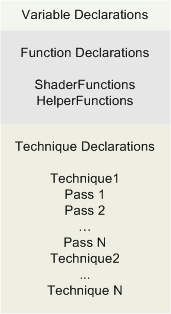Effect Format (Direct3D 11)
An effect (which is often stored in a file with a .fx file extension) declares the pipeline state set by an effect. Effect state can be roughly broken down into three categories:
- Variables, which are usually declared at the top of an effect.
- Functions, which implement shader code, or are used as helper functions by other functions.
- Techniques, which can be arranged in effect groups, and implement rendering sequences using one or more effect passes. Each pass sets one or more state groups and calls shader functions.

The preceding diagram shows the categories of effect state.
The definition of the effect binary format can be found in Binary\EffectBinaryFormat.h in the effects source code.
In this section
| Topic | Description |
|---|---|
| Effect Variable Syntax |
An effect variable is declared with the syntax described in this section. |
| Annotation Syntax |
An annotation is a user-defined piece of information, declared with the syntax described in this section. |
| Effect Function Syntax |
An effect function is written in HLSL and is declared with the syntax described in this section. |
| Effect Technique Syntax |
An effect technique is declared with the syntax described in this section. |
| Effect State Groups |
Effect states are name value pairs in the form of an expression. |
| Effect Group Syntax |
An effect group is declared with the syntax described in this section. |